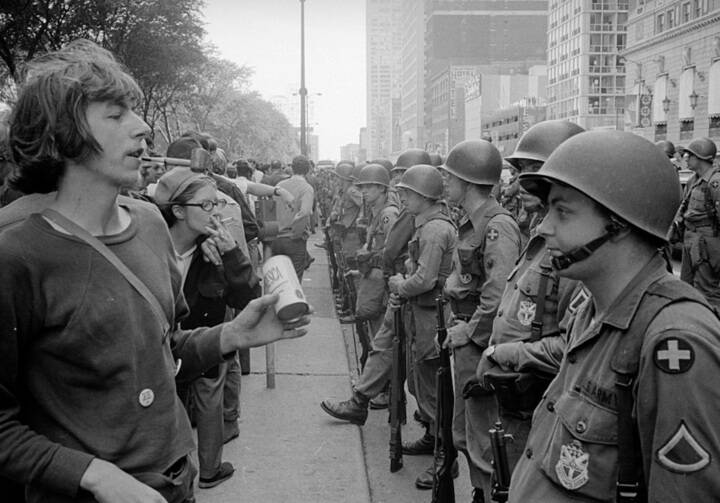Editor’s note: This article originally appeared in America on September 14, 1968, titled “The Other Convention.”
Chicago saw two conventions last month: the one made up of elected delegates of the Democratic party and staged in the amphitheatre for the television world, the other made up of young people in the parks. When Arthur Miller heard the boos at the first convention against a motion to recess Wednesday night’s nominating session out of sympathy for the students who were being beaten by police downtown, he saw it as a mass act of hatred against the young people.
Yet Chicago last month belonged to the young. This year the word had gone out that the Democratic convention was where the action was. Chicago and the Democrats might have been flattered that thousands of young people were pouring into town: both the “straight” types—candidates’ staffers with sideburns reasonably trimmed, in madras blazers—and their less conventional brothers, hair cascading to their shoulders, barefoot, wearing levis, ragged open shirts, medallions and beads.
[Related: As the Democratic Convention opens in Chicago, lessons from an eerily similar year: 1968]
Both groups arrived in an armed camp. Those with credentials were embraced by jazz bands and Daley workers in straw hats and red and white vests. The hippies and yippies, who could have been absorbed—with some imagination—into the city’s life, were treated like invaders from Mars. Finally, a militant minority had come to challenge “the system,” to force the power bloc personified by the Democratic National Committee and Mayor Richard J. Daley into a confrontation that would expose its weakness, its violence and its fear.
The mayor and the police played right into their hands. The first downtown skirmish erupted Monday afternoon in Grant Park, under the eyes of the convention headquarters Conrad Hilton, “the world’s largest and friendliest hotel.” As I crossed Michigan Ave., several hundred dissenters had just scaled a hill and surrounded the equestrian statue of Civil War General John Logan to protest the arrest of rebel leader Tom Hayden. An Antioch College boy scampered up on Gen. Logan’s iron shoulders and waved a sign of victory. The crowd cheered and the police attacked. An angry red-headed policeman tugged at the boy’s foot. “Let me go. I’ll come down!” the boy cried. The policeman kept yanking, then pounded his fist into the boy’s groin, as several police dragged the boy, writhing in pain, to the ground. “Why couldn’t you just leave him up there?” I asked the red-head. “If you want him up there,” he screamed, “you go fight in Vietnam.” This was not an isolated incident; it set the tone for most of the week.
The yippie-sponsored Tuesday night “L.B.J. Unbirthday Party” in the crumbling Chicago Coliseum was billed as a “festival of life” in answer to the convention hall’s anti-peace plank “festival of death.” An odd trio of heroes—William Burroughs, Jean Genet and Allen Ginsberg—read brief, incoherent statements calling the police “dogs.” They had been routed from Lincoln Park the night before. Realist editor Paul Krassner led an obscene cheer. Draft cards were burned and the American flag was replaced by North Vietnam’s. Mobilization leader David Dellinger urged the young to put their bodies on the line in Wednesday’s march to the amphitheatre.
Then folk singer Phil Ochs, in the evening’s most decent moment, warned the young to beware of all leaders and not to vulgarize themselves in opposing the vulgarity of their enemies. With all its rock music and light, the party was an ugly affair, too reminiscent of a frenzied revival meeting or of those frightening newsreels of the 1930’s of Hitler Jugend giving their salutes.
The real festival of life was in Grant Park each night from midnight till 5 A.M. There, like French peasants gathered outside the walls of an 18th century castle, the dissenting community regrouped, surrounded by one wall of helmeted blue-shirts and another of national guardsmen. There they sang and shared moments of terror—like the first 3:10 A.M. arrival of the troops and the first sighting of machine guns. They talked politics, met old friends and made new ones.
These 10,000 demonstrators were not all social dropouts. They were students—articulate, gentle, generous and concerned. Yes, there were rock throwers among them who wandered around shouting “Revolution!” and chanting for Ho Chi Minh. But they were easy to spot, and at no time did they gain control of the crowd. The park was a cross section of activist youth: McCarthy crusaders, a few blacks, curious boys from the suburbs, seminarians, boys from college newspapers, veterans back from Vietnam.
One by one both leaders and people from the ranks came to the portable public address system set up in the park and spoke to the crowd. They also spoke to the other America in the Hilton across the street. Calling across the abyss of Michigan Ave., they explained their opposition to the war. “You up there! If you are with us, flash the lights in your windows.” All over the building, lights flashed. “Join us! Join us!” the crowd cried back. One by one, they did. Wednesday night John Kenneth Galbraith came over. A South African Anglican bishop in red robes promised a Eucharist in the park at dawn. Elderly delegates and their wives, newsmen, clergy and Chicago citizens milled around listening, debating, offering help and shelter. A new community was being born.
Finally, around 4 A.M. Thursday—after the peace plank and the peace candidates had gone down to defeat in the convention hall—500 McCarthy delegates, carrying candles like medieval penitents, marched solemnly down the avenue into the ranks of the young. For a moment, at least, the two conventions and the two Americas had met.








